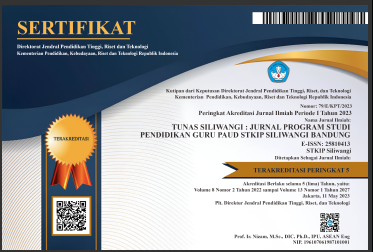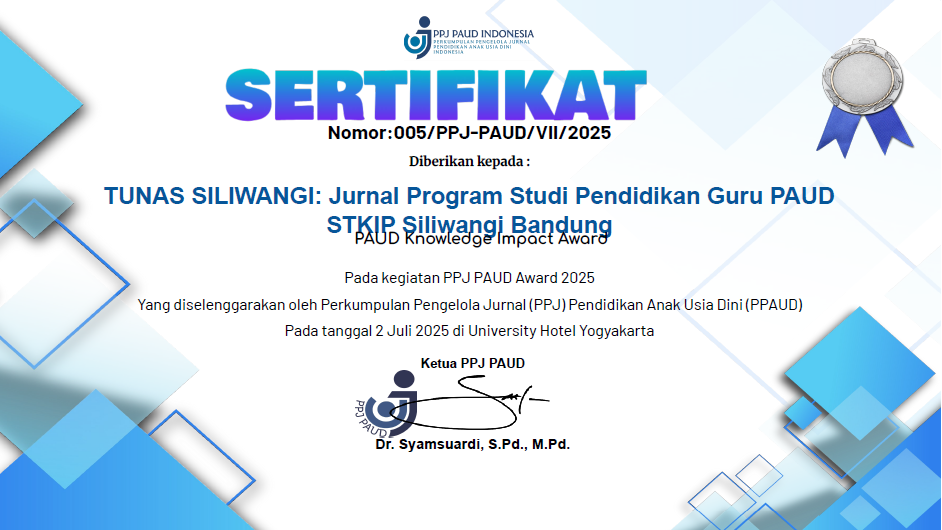Habituation method as an effort to form disciplined character in early childhood
DOI:
https://doi.org/10.22460/ts.v11i2.6659Keywords:
Habituation Method, Character Education, Discipline Character, Early ChildhoodAbstract
The problem of low discipline in early childhood is still often found in various early childhood education institutions, characterized by children's lack of ability to obey rules, take responsibility, and be independent. This is due to the inconsistent and unprogrammed application of habituation methods by educators. This study aims to examine the application of habituation methods in shaping the discipline of early childhood through a literature study of six scientific works in the form of four journal articles and two theses. The data were analyzed descriptively through the stages of reduction, categorization, and interpretation. The results of the study show that habit formation methods that are applied consistently, through simple routines and teacher role modeling, are able to shape disciplined behavior in children. Habit formation carried out in the school environment contributes significantly to the character formation of children, especially when supported by parental involvement
References
Aini, N. Q., Faturohman, N., & Darmawan, D. (2023). The Application of Character Education Reinforcement Through Habituation Methods for the Formation of Independence in Early Childhood at KB Azzahroh Serang. JECIE (Journal of Early Childhood and Inclusive Education), 6 (2), 98–113. https://doi.org/10.31537/jecie.v6i2.1051
Amalia, A. P., & Harfiani, R. (2024). Application of Positive Habituation in Efforts to Improve Children's Character. Murhum: Journal of Early Childhood Education, 5 (1), 25–38. https://doi.org/10.37985/murhum.v5i1.425
Andre Febrianto, Rusdy A Siroj, & Hartatiana. (2024). Literature Study: The Foundation for Choosing the Right Research Method. Journal Educational Research and Development | E-ISSN: 3063-9158, 1 (2)
Anggraeni, C., Elan, E., & Mulyadi, S. (2021). Habituation Methods for Instilling Discipline and Responsibility at Ra Daarul Falaah Tasikmalaya. Jurnal Paud Agapedia, 5 (1), 100–109. https://doi.org/10.17509/jpa.v5i1.39692
Bustamam, M. (2024). Review of Skinner's Method in Shaping the Behavior of Early Childhood Children at Raudhatul Ula Kindergarten in East Aceh. Seumubeuet Journal: Journal of Islamic Education, 3 (1), 11–20. https://ejournal.ymal.or.id/index.php/jsmbt/article/view/89
Habsy, B. A., Mufidha, N., Shelomita, C., Rahayu, I., & Muckorobin, M. I. (2023). Basic Philosophy in Psychoanalytic Counseling: A Literature Review. Indonesian Journal of Educational Counseling, 7 (2)
Ihsani, N., Kurniah, N., & Suprapti, A. (2018). The Relationship Between Habituation Methods in Learning and Discipline in Early Childhood. Potensia Scientific Journal, 3 (1), 50–55. https://doi.org/10.33369/jip.3.2.105-110
Kurniati, E. (2025). Vygotsky's Sociocultural Theory for Early Childhood. Journal of Early Childhood Education Studies, 1 (1), 19–24. https://www.putrapublisher.org/ojs/index.php/jspaud/article/view/703
Machfiroh, L., Desyanty, E. S., & Rahma, R. A. (2019). Character Building of Discipline in Early Childhood Through Habituation Methods at Aisyiyah Bustanul Athfal 33 Kindergarten in Malang City. Journal of Nonformal Education, 14 (1), 54–67. https://doi.org/10.17977/um041v14i1p54-67
Mahanum, M. (2021). Literature Review. Alacrity: Journal of Education, 1 (2), 1–12. https://doi.org/10.52121/alacrity.v1i2.20
Maryatun, I. B. (2016). The Role of Early Childhood Educators in Building Children's Character. Journal of Early Childhood Education, 5 (1), 747–752. https://doi.org/https://doi.org/10.21831/jpa.v5i1.12370
Mawardah, E. Y., & Hariyanti, D. P. D. (2023). Instilling Habits to Develop Discipline in Children Aged 5-6 Years. A Pleasant Transition from Early Childhood Education to Elementary School, 1–14. https://conference2.upgris.ac.id/index.php/snpaud/article/view/27
Mawardah, E. Y., Prasetyo, A., & Kusumaningtyas, N. (2024). Application Of The Habituation Method To Form Disciplined Character In 5-6 Year Old Children At Tk Muslimat Buloh II. IJES: Indonesia Journal of Elementary School, 4(24), 264–270.
Nurhayati, I., Hidayat, R., & Hidayat, Y. (2024). The Use of Habituation Methods in Shaping the Disciplined Character of 5-6 Year Old Children at Sartika Asih Mekarmulya Early Childhood Education Center. Intisabi Journal, 2 (1), 68–87. https://doi.org/10.61580/itsb.v2i1.53
Nurhayati, I., Kurniasih, N., Susanti, S., & Hidayat, Y. (2024). The Effect Of Using The Habituation Method On The Formation Of Disciplined Character In Children At Sartika Asih Early Childhood Education Center, Ciamis Regency, West Java. Al Ihsan: Journal of Islamic Education for Early Childhood, 5(1), 44–60.
Puspitasari, A., Fahmi, F., & Maryani, K. (2023). The Effect of the School Environment on the Formation of Discipline in Children Aged 5-6 Years. Jurnal Raudhah, 11 (1), 1–10. https://doi.org/10.30829/raudhah.v11i1.2625
Samsinar, Fatimah, S., & Adrianti, R. (2022). Character Education for Early Childhood. In Akademia Pustaka (Vol. 4, Issue 1). https://doi.org/10.52266/pelangi.v4i1.816
Sudaryati. (2012). The Importance of Character Education for Early Childhood. Journal of Early Childhood Education, 1 (1), 11–20. https://doi.org/10.24114/jud.v7i2.30585
Wuryandani, W., Maftuh, B., & Budimansyah, D. (2019). Discipline Character Education in Elementary Schools. Cakrawala Pendidikan, 2 (2), 286–295. https://doi.org/10.21831/cp.v2i2.2168
Yusnita, N. C., & Muqowim. (2020). Student-Centered Learning Approach in Instilling Discipline and Independence in Children at Annur I Kindergarten. Potensia Scientific Journal, 5 (2), 116–126. https://doi.org/10.33369/jip.5.2.%p
Downloads
Published
Issue
Section
License
Copyright (c) 2025 Rifasya Nurfadillah, Elan, Purwati

This work is licensed under a Creative Commons Attribution-ShareAlike 4.0 International License.
The author is responsible for acquiring the permission(s) to reproduce any copyrighted figures, tables, data, or text that are being used in the submitted paper. Authors should note that text quotations of more than 250 words from a published or copyrighted work will require grant of permission from the original publisher to reprint. The written permission letter(s) must be submitted together with the manuscript.







